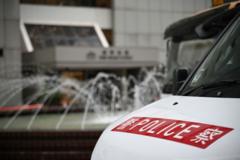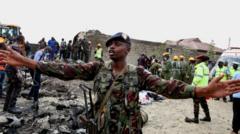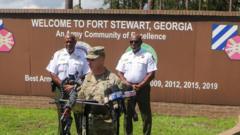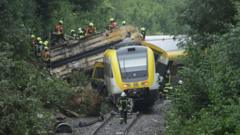As recovery efforts commence after the devastating Air India crash in Ahmedabad that claimed over 200 lives, emergency teams are confronted with significant challenges, including the risk of collapsing structures and hazardous gas leaks. The operation to recover victims, search for any survivors, and investigate the cause of the crash requires careful stabilization of damaged buildings, particularly those impacted by the Boeing Dreamliner shortly after takeoff.
Air India Crash in Ahmedabad: Authorities Face Challenges in Recovery Efforts

Air India Crash in Ahmedabad: Authorities Face Challenges in Recovery Efforts
Emergency teams are grappling with unstable structures and gas leaks post-Air India tragedy.
Experts in aviation and disaster response are voicing concerns about the methodical and lengthy nature of the recovery process. Shawn Pruchnicki, a former airline accident investigator, estimates that it could take up to a month to navigate the complexities of this situation effectively. Emergency responders must prioritize the safety of their operations while also striving to locate any potential survivors trapped beneath the wreckage and debris.
The current focus is on stabilizing structures around B.J. Medical College, where many casualties were reported, before disentangling pieces of the aircraft. This includes using cranes to carefully remove large aircraft components from the buildings without further compromising their integrity. Meanwhile, investigators are eager to access crucial telemetry data from the flight's black box to understand the crash’s causes fully, though they face additional challenges because of the urban landscape and the potential presence of ruptured gas lines.
The unfolding situation highlights the urgent need for coordinated responses in densely populated areas, marking this incident as one of considerable complexity and human tragedy.
As the days progress, the firefighting and rescue efforts continue amid a backdrop of perilous conditions. Authorities insist that while the discovery of lives is paramount, an equally important goal is to prevent further risks to safety as they delve into the aftermath of this catastrophic event.
The current focus is on stabilizing structures around B.J. Medical College, where many casualties were reported, before disentangling pieces of the aircraft. This includes using cranes to carefully remove large aircraft components from the buildings without further compromising their integrity. Meanwhile, investigators are eager to access crucial telemetry data from the flight's black box to understand the crash’s causes fully, though they face additional challenges because of the urban landscape and the potential presence of ruptured gas lines.
The unfolding situation highlights the urgent need for coordinated responses in densely populated areas, marking this incident as one of considerable complexity and human tragedy.
As the days progress, the firefighting and rescue efforts continue amid a backdrop of perilous conditions. Authorities insist that while the discovery of lives is paramount, an equally important goal is to prevent further risks to safety as they delve into the aftermath of this catastrophic event.




















